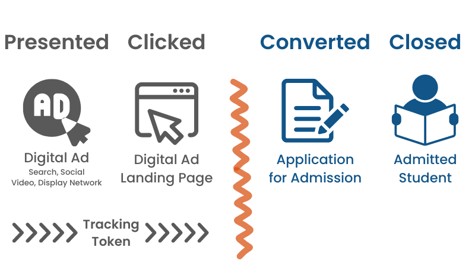4 Winning Strategies for your Institution's Digital Advertising
Most institutions spend well upwards of $250,000 per year on digital advertising to recruit new students. Yet, most marketing and admissions leaders have no visibility into the effectiveness of those campaigns -- which prevents them from making key decisions affecting their success.
Digital Marketing Primer
Before going into our recommendations, let's discuss how digital marketing often works in a higher education context. The general processes and methods are very similar to how search and other digital advertising works in general.
- An institution identifies a channel and audience within that channel to target an advertisement or campaign.
- That institution then creates the content of the advertisement or campaign, including messaging that is intended to resonate with that audience.
- A call to action is defined, created, and linked to the advertisement. In most circumstances, this is a landing page or form.
How this works for the Prospective Student

From the perspective of a prospective student, here is how this works:
- The student is presented an ad (for example, it may be displayed in a search engine result)
- The user clicks on the ad, and is taken to a landing page with more information. The context of the ad is passed to the landing page so that the advertiser can track the activity with that ad.
- The user can then take the action of starting an application for admission. Although most digital advertising platforms have the ability to pass context on, cloud-based admissions solutions are unable to utilize that token. This means that any activity after the user takes after the landing page (including identifying who he/she is) is lost.
The 4 recommendations
Now that we've covered how digital marketing works, let's go into each of the 4 recommendations and some of the challenges that might be faced in following them.
Step 1 - Get visibility into application activity
The first, and most important, step is to get visibility into application activity in a way that you can tie it back to your digital marketing campaigns and channels. Without this information, you cannot take any of our other recommended steps.
The three most important metrics to you as a digital advertiser are:
- How many people are seeing my ad / campaign
- How many people start and complete an application for admission from my ad / campaign
- How many people ultimately enroll from my ad / campaign
Because the purpose of your digital advertising efforts is to enroll students, the only way to truly measure its success is to know application and enrollment activity related to a given ad or campaign. Without implementing tracking in the application for admissions, you cannot determine either of those two pieces of information. As a stop-gap, digital marketers often create a landing page to capture clicking activity from the ad which indicates how often people interact (versus ignore) the ad.
Unfortunately, this is impossible when your institution doesn't have control over the application for admissions solution. The tracking token infrastructure for your institution must be added to the software hosting your applications for admissions -- and other SaaS application for admissions solutions don't support this.
If you have your own application for admissions solution, your digital marketing provider most likely has code that you can embed into it. If you're a Mutara customer, we support this as well.
Step 2 - Define Granular Marketing Campaigns
When you have the ability to tie your digital marketing activities to application and enrollment activity, you can unlock the value of doing more precision digital marketing. For different programs / degrees, you might be able to identify specific demographics, keywords, and channels to try. Being more granular allows you to target the messaging to them and to place ads only to the people who you think would be a good fit.
To do this, however, you need the ability to define, implement, and measure how these campaigns perform. Any one of the following can affect your success:
- The messaging and contents of the ad
- The channel in which the ad is presented. This could be search, social media, YouTube, a website, or a display network ecosystem
- The format of the ad. This could be an image, a video, or a social post
- The audience to whom the ad is targeted. This could be a search keyword, a group, or demographics
Step 3 - Perform A/B testing
Once you have your campaigns defined, you will have multiple choices in terms of the 4 items listed in the previous step. A/B testing is a great method for you to segment your activities and test out your messaging, format, and audience to determine what is most effective in helping you reach your goals. Again, being able to measure the level of success you have in not just getting people to click on your ads -- but measure how many apply and ultimately enroll is critical to this effort.
Step 4 - Pivot Quickly and Often
Finally, you will want to measure and adjust several times within an admissions cycle. If your institution has an annual enrollment cycle, what you learn today may or may not be applicable in the enrollment cycle. However, if you have the ability to iterate several times a month, you will achieve much better results. This works extremely well with A/B testing.
The process would work something like this:
- Deploy a digital ad and document all of the components of it (audience, channel, content, format).
- Measure the effectiveness through the metrics available
- How many people are presented the ad
- How many people clicked on the ad
- How many people began an application for admissions
- How many people submitted an application for admissions
- How many people accept and enroll (depending on timing, this may not be available)
- Analyze the results to determine options for next iteration. Here are a few potential learnings
- If the ad isn't presented to enough people, perhaps the channel isn't appropriate, or whether the definition of the audience is too limiting
-
- If a large number of people click on an ad, but don't start an application for admissions, perhaps the content of the ad is misleading
- If the ad is presented to a large number of people, but few people click on it, you might need to review any of the components (who it's going to, the content, the channel, and the format). This is where A/B testing will be important where only one area is different between the options -- this will help you hone in on why it's not connecting.
Summary
The key to ensuring you optimize your digital advertising results is to follow a continuous improvement process. Publish, measure, adjust, and repeat. However, without the ability to adequately measure your advertising results in a manner where they can be tied back to your decisions; your institution is flying blind.
If you're interested in learning how our customers are able to accomplish this, we'd love to talk with you.


